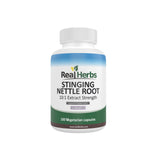How to Eat Stinging Nettle Leaves?
Introduction
Do you often walk past those pesky stinging nettle plants in your backyard, unaware of the hidden nutritional treasure they hold? Stinging nettle leaves, scientifically known as Urtica dioica, might seem like an unwelcome garden guest due to their stinging hairs. However, beneath their prickly exterior lies a powerhouse of nutrients and potential health benefits waiting to be harnessed. In this article, we'll explore the art of safely and deliciously incorporating stinging nettle leaves into your diet.
What Are Stinging Nettle Leaves?
Stinging nettle, a perennial plant found in many parts of the world, is known for its characteristic stinging hairs that can cause skin irritation upon contact. But don't be quick to dismiss this plant; its leaves are rich in vitamins, minerals, and bioactive compounds that have been used for centuries in traditional medicine and culinary practices.
Nutritional Profile
Stinging nettle leaves are a nutritional goldmine. They contain essential vitamins such as A, C, and K, as well as minerals like iron, calcium, and magnesium. Additionally, they're a source of protein, fiber, and antioxidants, making them a valuable addition to a balanced diet.
Health Benefits
The consumption of stinging nettle leaves has been associated with various health benefits.
-
Anti-Inflammatory Properties: Stinging nettle contains compounds that may help reduce inflammation in the body. This can be particularly beneficial for individuals dealing with conditions like arthritis.
-
Allergy Relief: Some people use stinging nettle as a natural remedy for seasonal allergies. Its potential antihistamine effects may provide relief from sneezing and itchy eyes.
-
Improved Digestion: The high fiber content in nettle leaves can aid in digestive health. It may help alleviate common issues like constipation and promote a healthy gut.
As we delve deeper into this article, we'll explore these benefits and how you can harness them.
Safety Precautions
Before we dive into the culinary world of stinging nettle leaves, it's essential to address their stinging nature. Touching these leaves without protection can lead to skin irritation.
-
Safe Handling: When harvesting stinging nettle leaves, always wear gloves and use scissors or garden shears to cut the stems. This will prevent direct contact with the stinging hairs.
-
Cooking Removes the Sting: The good news is that cooking or drying stinging nettle leaves neutralizes their stinging hairs, making them safe to eat. We'll discuss various culinary methods shortly.
-
Consult a Professional: If you have allergies or are taking medications, consult a healthcare professional before adding stinging nettle leaves to your diet.
Now, let's move on to the practical aspects of incorporating stinging nettle leaves into your meals.
How to Harvest Stinging Nettle Leaves
Stinging nettle leaves are best harvested in the spring when they are young and tender. Here's how to do it safely:
-
Gear Up: Wear gloves, long sleeves, and long pants to protect your skin from stings.
-
Look for Young Plants: Younger leaves are more tender and flavorful. Look for plants less than a foot tall.
-
Snip the Tops: Use scissors or garden shears to snip off the top 4-6 inches of the plant, where the most tender leaves are found.
-
Avoid Roadside Plants: Make sure to harvest nettle leaves from areas free of pesticides and pollutants. Avoid roadside plants.
Now that you've safely harvested your nettle leaves, it's time to explore some culinary options.
Culinary Uses
Stinging nettle leaves can be incorporated into your diet in various ways:
-
Nettle Tea: One of the simplest methods is to make nettle tea. Steep the leaves in hot water for a soothing and nutrient-rich herbal tea.
-
Sautéing: Sauté nettle leaves with garlic and olive oil for a delicious side dish. Cooking removes the sting, leaving you with a spinach-like flavor.
-
Soup and Stews: Add chopped nettle leaves to your favorite soups or stews for an extra nutritional boost.
-
Pesto and Smoothies: Blend nettle leaves into pesto sauce or add them to your morning smoothie for a nutrient-packed kick.
Storing and Preserving
To enjoy stinging nettle leaves beyond the harvesting season, consider these preservation methods:
-
Drying: Dry nettle leaves by hanging them in a well-ventilated area. Once dried, store them in an airtight container.
-
Freezing: Blanch nettle leaves in boiling water for a minute, then plunge them into ice water. Once cooled, drain and freeze them in portions for later use.
Potential Side Effects
While stinging nettle leaves have numerous potential benefits, they may not be suitable for everyone.
-
Allergic Reactions: Some individuals may be allergic to stinging nettle. If you experience symptoms like itching, swelling, or difficulty breathing after consuming it, seek immediate medical attention.
-
Medication Interactions: If you're taking medications or have underlying health conditions, consult a healthcare professional before adding stinging nettle leaves to your diet, as they can interact with certain medications.
Conclusion
Incorporating stinging nettle leaves into your diet can be a nutritious and flavorful experience. By following safety precautions, harvesting, and preparing them correctly, you can unlock their potential health benefits. Remember to start with small quantities and consult a healthcare professional if you have any concerns. Explore the world of stinging nettle leaves, and you may discover a new favorite ingredient that enhances both your health and your culinary adventures.












